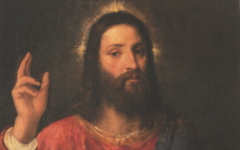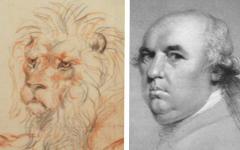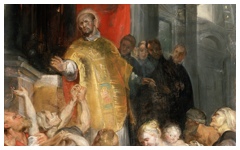Rubens’ Copy of Titian’s Charles V in Armor with a Drawn Sword (c.1603)
Rubens copied Titian's now-lost portrait of Emperor Charles V holding a drawn sword on his first visit to Spain in 1603-4 when he was in his mid-twenties. He had been born in Germany less than a year after Titian had died in Venice. Assuming that Rubens' copy (below) is relatively faithful, the Italian artist had depicted the Emperor's "sword" like an erect phallus on a man of steel. The man in armor is both "king" and Superman representing the artistic soul which is fertile and creative. This is not unusual. Bronzino (1503-1572) had already written a poem equating a paintbrush with a phallus just as more recent artists like Renoir (1841-1919) have made similar references.1 Picasso, for the same reason, used to paint or draw an artist's brushes near his or her groin. The "Emperor's" shining armor further suggests that he is the central inner core of the human self. The armor by reflecting back the world outside represents a protective shell for the human soul that we all share, however hidden it may be in the muddy darkness of our minds.

Rubens, After Titian's Charles V in Armor with a Drawn Sword (c.1603) Private Collection
Click image to enlarge.
Identifying with the Emperor, Titian placed the tip of the sword/"brush" outside the frame on the left as though the Emperor was "painting" a self-portrait on a canvas just out-of-view while turning to check his figure in the mirror.
The helmet's circular shape at upper right further suggests, in line with the "paintbrush", a helmet-like "palette" though its shining reflections might also refer to an artist's "eyeball" or, perhaps more accurately, the inner eyeball of his imagination.
Click next thumbnail to continue

Left: Titian, Portrait of Emperor Charles V (date uncertain) Museo di Capodimonte, Naples
Right: Detail of Rubens' Copy of Titian's Charles V in Armor with a Drawn Sword
Click image to enlarge.
If we compare Rubens' copy of the Emperor's face (right) to another early portrait of the Emperor by Titian (left) the copy initially appears quite faithful. The lower lip, for instance, of the famous Hapsburg jaw is there in both portraits. However, the tip of the nose, faceted at far left, becomes rounded in Rubens' copy.2 Look at the near eye too; it seems similar but....
Click next thumbnail to continue

Left: Detail of Rubens' Copy of Titian's Charles V (c.1603)
Right: Rubens, Self-Portrait in a Circle of Friends from Mantua. (c.1603-4), detail rotated. Wallraf-Richartz Museum, Cologne, Germany
Click image to enlarge.
...in comparing it to a contemporaneous self-portrait by Rubens you get a sense of greater similarity despite the lack of a hooded eyelid. (Switch back and forth between this pair of images and the prior to compare the eyes.) Rubens' Emperor (far left) looks straight at us while Titian's (in prior pair) averts his eyes to avoid, perhaps, having a commoner look in the eyes of a king. Titian's other portraits of the young Emperor all look to the side.
Click next thumbnail to continue
In later life, with more self-confidence and greater acquaintance with the Emperor, Titian did depict the Emperor looking outwards but not in the early days.
To change the direction of an Emperor's eyes is a major step in the copying of an earlier masterpiece. No artist would do that lightly so the alteration must have important meaning. Rubens, like Titian, has turned the Emperor into an alter ego of his own self thereby identifying with the Italian master as well. Thus Rubens identifies with both Titian and his imaginal world, a link he would maintain and respect throughout his career, one masterpiece after another.
Notes:
1. Agnolo Bronzino, Rime in burla, ed. F. Petrucci Nardelli, Rome, 1988, pp.23-6, cited in Cropper and Dempsey, Nicolas Poussin: Friendship and The Love of Painting (Princeton University Press) 1996, pp. 244-5
2. In all Titian's portraits of the Emperor the nose has a sharp tip to it, as though one side has been carved off.
Original Publication Date on EPPH: 26 Jun 2012. | Updated: 0. © Simon Abrahams. Articles on this site are the copyright of Simon Abrahams. To use copyrighted material in print or other media for purposes beyond 'fair use', you must obtain permission from the copyright owner. Websites may link to this page without permission (please do) but may not reproduce the material on their own site without crediting Simon Abrahams and EPPH.




